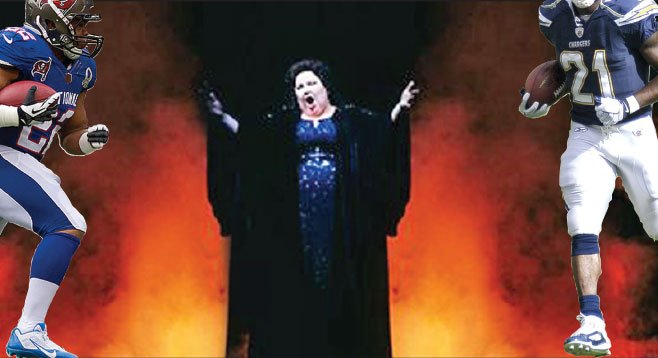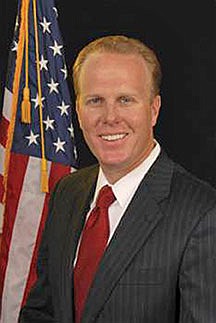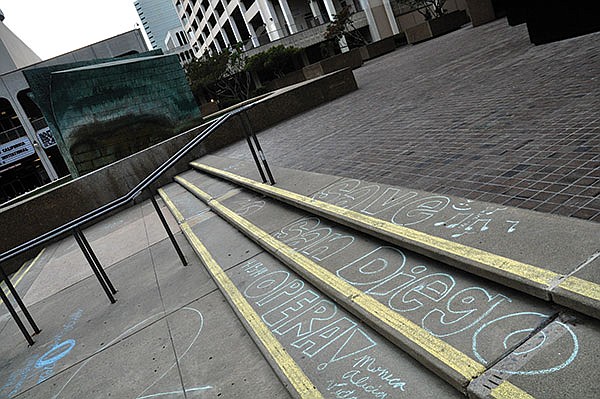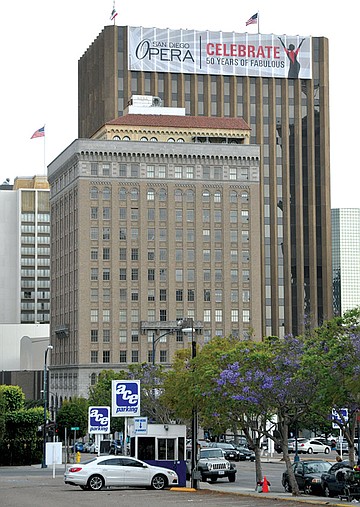 Facebook
Facebook
 X
X
 Instagram
Instagram
 TikTok
TikTok
 Youtube
Youtube

"It ain’t over till the fat lady sings.” Excited TV announcers belt out that colloquialism at sports events that could be won by either side, even if one team seems to be comfortably ahead.
Those sportscasters would be embarrassed to know the axiom’s derivation. It comes from the end of Richard Wagner’s four-opera, 16-hour Der Ring des Nibelungen. The last of the four operas, Götterdämmerung, ends as the usually corpulent soprano Brünnhilde, warbling at high pitch, mounts her steed and plunges into the funeral pyre, when Valhalla crumbles and the gods are destroyed.
How many jockstraps know that their favorite aphorism was first uttered in 1976 by a college sports information director who apparently knew opera?
Hey, sports and serious music don’t mix. Everyone knows that. Billionaire owners of pro sports teams get massive taxpayer subsidies to build stadiums and arenas; arts groups get crumbs, if that.

Consider San Diego. On March 19, San Diego Opera suddenly announced it wanted to go out of business at the end of this season. The matter is still up in the air. Mayor Kevin Faulconer stated, “Spending taxpayer funds to save the opera won’t be an option because they will be spent on my priorities, which are street repairs and neighborhood services.” Faulconer said he would help the philanthropic community raise the funds.
The part about street repairs and neighborhoods is bunk. Within a few weeks, Faulconer’s aides were sitting down with the San Diego Chargers to talk turkey — that is, a massively taxpayer-subsidized stadium for the team, which would be a real turkey. U-T San Diego said taxpayers would chip in $400 million to $600 million of the roughly $900 million to $1 billion or more total cost. That would be on a par with the percentage taxpayers shell out in other stadium deals, quoth the U-T.
More bunk. The definitive work on this topic came from Harvard’s Judith Grant Long, who two years ago found that taxpayers on average pick up 78 percent of stadium payments. The costs of land, infrastructure, operations, capital improvements, municipal services, and lost property taxes add 25 percent to the taxpayer bill. Those initial lowball forecasts are phony enticements to voters.
Not long after Faulconer nixed an opera bailout, San Diego put in its bid for the 2024 Olympics. The 2008 Beijing Summer Olympics cost $40 billion. The 2012 London Summer Olympics came in at $15 billion.
“The Olympic games are awash in fiscal myths,” said the British newspaper the Guardian late last year. “Games boosters always roll out tantalizing promises. One common claim is that the Olympics are a windfall for the host city.” However, “Academic economists simply haven’t found a positive relationship between hosting the Games and economic growth.” Economist Jeffrey Owen says, “It is unlikely that anyone ever will.” Said the Guardian, “Underestimating Olympic costs has almost become an Olympic sport in itself.”

The Economist says hotel bookings actually dropped during the 2008 Beijing Olympics. Nevertheless, hosting the games is “wildly popular with the voters who foot the bill.” San Diegans will be told that the Olympics — like the Chargers stadium — won’t cost much. Don’t believe a word of either claim.
No one should be surprised that a report released early this month by the American Association of University Professors showed that from 2004 to 2011, inflation-adjusted spending for athletics at big and medium-sized universities, and small colleges and community colleges, went up 24.8 percent, while spending on instruction and academic support was about flat and public services and research declined.
The purpose of higher education is education? What are you? Some kinda weirdo?
While professional- and amateur-sports spending soars, classical music — opera, symphonic, and chamber — is dying of old age. Less than 3 percent of recording album sales are classical. According to Slate, the percentage of adults going to a classical concert (even once a year) dropped from 13 in 1982 to 8.8 in 2012. Classical music radio stations are drying up.
Seattle Symphony reports that 32 percent of its regular-season audience has postgraduate degrees. When it does Wagner’s Ring Cycle it’s 39 percent. Brünnhilde may be plump, but she brings out the well-educated folks.
In 1937, the median age at Los Angeles orchestra concerts was 28, says Slate. It’s probably over 50 now. Music education has been in decline for years. That’s one of the major reasons San Diego Opera attendance has fallen so sharply.
So, it’s clear why a politician like Mayor Faulconer will toss gobs of public money at sports teams owned by billionaires and offer nothing to an opera company on the brink. (The opera is slated to get $389,357 from the city’s Special Promotional Programs this year. The symphony will get $411,870 and the Old Globe $421,074.)

Politicians know that sports are where the votes are. Personally, I don’t like government subsidies for professional sports or the arts. There is no question that classical music appeals to an elderly, elite audience that should pay its own way. Even Europeans, longtime arts subsidizers, are rethinking the practice, given the weak economy.
But the wealthy and elite really aren’t supporting classical music — or any charities — the way they should. According to the Chronicle of Philanthropy, Californians with compensation of $50,000 to $99,999 give 6.2 percent of their incomes to charity. The favored few who make $200,000 and above give 4 percent. In particular, the affluent who huddle in one neighborhood are penny-pinchers in charitable giving. In city after city, it’s the low-income residents who lift giving levels, according to the Chronicle.
The same pattern holds true with corporations. In 2012, according to the Committee Encouraging Corporate Philanthropy, Fortune 500 (the largest) companies gave 0.09 percent of their revenue to charities. Smaller companies gave 0.14 percent.
And according to Giving USA, only 5 percent of 2012’s total charitable giving went to culture, the arts, and humanities. Taxpayers should not have to support the wealthy — except in the case of billionaire sports-team owners, according to the politicians who pander to pedestrian tastes.


"It ain’t over till the fat lady sings.” Excited TV announcers belt out that colloquialism at sports events that could be won by either side, even if one team seems to be comfortably ahead.
Those sportscasters would be embarrassed to know the axiom’s derivation. It comes from the end of Richard Wagner’s four-opera, 16-hour Der Ring des Nibelungen. The last of the four operas, Götterdämmerung, ends as the usually corpulent soprano Brünnhilde, warbling at high pitch, mounts her steed and plunges into the funeral pyre, when Valhalla crumbles and the gods are destroyed.
How many jockstraps know that their favorite aphorism was first uttered in 1976 by a college sports information director who apparently knew opera?
Hey, sports and serious music don’t mix. Everyone knows that. Billionaire owners of pro sports teams get massive taxpayer subsidies to build stadiums and arenas; arts groups get crumbs, if that.

Consider San Diego. On March 19, San Diego Opera suddenly announced it wanted to go out of business at the end of this season. The matter is still up in the air. Mayor Kevin Faulconer stated, “Spending taxpayer funds to save the opera won’t be an option because they will be spent on my priorities, which are street repairs and neighborhood services.” Faulconer said he would help the philanthropic community raise the funds.
The part about street repairs and neighborhoods is bunk. Within a few weeks, Faulconer’s aides were sitting down with the San Diego Chargers to talk turkey — that is, a massively taxpayer-subsidized stadium for the team, which would be a real turkey. U-T San Diego said taxpayers would chip in $400 million to $600 million of the roughly $900 million to $1 billion or more total cost. That would be on a par with the percentage taxpayers shell out in other stadium deals, quoth the U-T.
More bunk. The definitive work on this topic came from Harvard’s Judith Grant Long, who two years ago found that taxpayers on average pick up 78 percent of stadium payments. The costs of land, infrastructure, operations, capital improvements, municipal services, and lost property taxes add 25 percent to the taxpayer bill. Those initial lowball forecasts are phony enticements to voters.
Not long after Faulconer nixed an opera bailout, San Diego put in its bid for the 2024 Olympics. The 2008 Beijing Summer Olympics cost $40 billion. The 2012 London Summer Olympics came in at $15 billion.
“The Olympic games are awash in fiscal myths,” said the British newspaper the Guardian late last year. “Games boosters always roll out tantalizing promises. One common claim is that the Olympics are a windfall for the host city.” However, “Academic economists simply haven’t found a positive relationship between hosting the Games and economic growth.” Economist Jeffrey Owen says, “It is unlikely that anyone ever will.” Said the Guardian, “Underestimating Olympic costs has almost become an Olympic sport in itself.”

The Economist says hotel bookings actually dropped during the 2008 Beijing Olympics. Nevertheless, hosting the games is “wildly popular with the voters who foot the bill.” San Diegans will be told that the Olympics — like the Chargers stadium — won’t cost much. Don’t believe a word of either claim.
No one should be surprised that a report released early this month by the American Association of University Professors showed that from 2004 to 2011, inflation-adjusted spending for athletics at big and medium-sized universities, and small colleges and community colleges, went up 24.8 percent, while spending on instruction and academic support was about flat and public services and research declined.
The purpose of higher education is education? What are you? Some kinda weirdo?
While professional- and amateur-sports spending soars, classical music — opera, symphonic, and chamber — is dying of old age. Less than 3 percent of recording album sales are classical. According to Slate, the percentage of adults going to a classical concert (even once a year) dropped from 13 in 1982 to 8.8 in 2012. Classical music radio stations are drying up.
Seattle Symphony reports that 32 percent of its regular-season audience has postgraduate degrees. When it does Wagner’s Ring Cycle it’s 39 percent. Brünnhilde may be plump, but she brings out the well-educated folks.
In 1937, the median age at Los Angeles orchestra concerts was 28, says Slate. It’s probably over 50 now. Music education has been in decline for years. That’s one of the major reasons San Diego Opera attendance has fallen so sharply.
So, it’s clear why a politician like Mayor Faulconer will toss gobs of public money at sports teams owned by billionaires and offer nothing to an opera company on the brink. (The opera is slated to get $389,357 from the city’s Special Promotional Programs this year. The symphony will get $411,870 and the Old Globe $421,074.)

Politicians know that sports are where the votes are. Personally, I don’t like government subsidies for professional sports or the arts. There is no question that classical music appeals to an elderly, elite audience that should pay its own way. Even Europeans, longtime arts subsidizers, are rethinking the practice, given the weak economy.
But the wealthy and elite really aren’t supporting classical music — or any charities — the way they should. According to the Chronicle of Philanthropy, Californians with compensation of $50,000 to $99,999 give 6.2 percent of their incomes to charity. The favored few who make $200,000 and above give 4 percent. In particular, the affluent who huddle in one neighborhood are penny-pinchers in charitable giving. In city after city, it’s the low-income residents who lift giving levels, according to the Chronicle.
The same pattern holds true with corporations. In 2012, according to the Committee Encouraging Corporate Philanthropy, Fortune 500 (the largest) companies gave 0.09 percent of their revenue to charities. Smaller companies gave 0.14 percent.
And according to Giving USA, only 5 percent of 2012’s total charitable giving went to culture, the arts, and humanities. Taxpayers should not have to support the wealthy — except in the case of billionaire sports-team owners, according to the politicians who pander to pedestrian tastes.
Comments